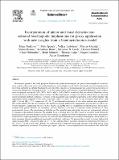Incorporation of minor and trace elements into cultured brachiopods : implications for proxy application with new insights from a biomineralisation model
Abstract
Brachiopods present a key fossil group for Phanerozoic palaeo-environmental and palaeo-oceanographical reconstructions, owing to their good preservation and abundance in the geological record. Yet to date, hardly any geochemical proxies have been calibrated in cultured brachiopods and only little is known on the mechanisms that control the incorporation of various key elements into brachiopod calcite. To evaluate the feasibility and robustness of multiple Element/Ca ratios as proxies in brachiopods, specifically Li/Ca, B/Ca, Na/Ca, Mg/Ca, Sr/Ca, Ba/Ca, as well as Li/Mg, we cultured Magellania venosa, Terebratella dorsata and Pajaudina atlantica under controlled experimental settings over a period of more than two years with closely monitored ambient conditions, carbonate system parameters and elemental composition of the culture medium. The experimental setup comprised of two control aquariums (pH0 = 8.0 and 8.15, T = 10 °C) and treatments where pCO2−pH (pH1 = 7.6 and pH2 = 7.35), temperature (T = 16 °C) and chemical composition of the culture medium were manipulated. Our results indicate that the incorporation of Li and Mg is strongly influenced by temperature, growth effects as well as carbonate chemistry, complicating the use of Li/Ca, Mg/Ca and Li/Mg ratios as straightforward reliable proxies. Boron partitioning varied greatly between the treatments, however without a clear link to carbonate system parameters or other environmental factors. The partitioning of both Ba and Na varied between individuals, but was not systematically affected by changes in the ambient conditions. We highlight Sr as a potential proxy for DIC, based on a positive trend between Sr partitioning and carbonate chemistry in the culture medium. To explain the observed dependency and provide a quantitative framework for exploring elemental variations, we devise the first biomineralisation model for brachiopods, which results in a close agreement between modelled and measured Sr distribution coefficients. We propose that in order to sustain shell growth under increased DIC, a decreased influx of Ca2+ to the calcifying fluid is necessary, driving the preferential substitution of Sr2+ for Ca2+ in the crystal lattice. Finally, we conducted micro-computed tomography analyses of the shells grown in the different experimental treatments. We present pore space – punctae – content quantification that indicates that shells built under increased environmental stress, and in particular elevated temperature, contain relatively more pore space than calcite, suggesting this parameter as a potential novel proxy for physiological stress and even environmental conditions.
Citation
Jurikova , H , Ippach , M , Liebetrau , V , Gutjahr , M , Krause , S , Büsse , S , Gorb , S N , Henkel , D , Hiebenthal , C , Schmidt , M , Leipe , T , Laudien , J & Eisenhauer , A 2020 , ' Incorporation of minor and trace elements into cultured brachiopods : implications for proxy application with new insights from a biomineralisation model ' , Geochimica et Cosmochimica Acta , vol. 286 , pp. 418-440 . https://doi.org/10.1016/j.gca.2020.07.026
Publication
Geochimica et Cosmochimica Acta
Status
Peer reviewed
ISSN
0016-7037Type
Journal article
Description
This project has received funding from the European Union’s Horizon 2020 research and innovation programme under the Marie Sklodowska-Curie grant agreement No. 643084 (BASE-LiNE Earth), and was also supported by the collaborative research initiative CHARON (DFG Research Group 1644 – Phase II) funded by the German Research Foundation.Collections
Items in the St Andrews Research Repository are protected by copyright, with all rights reserved, unless otherwise indicated.

